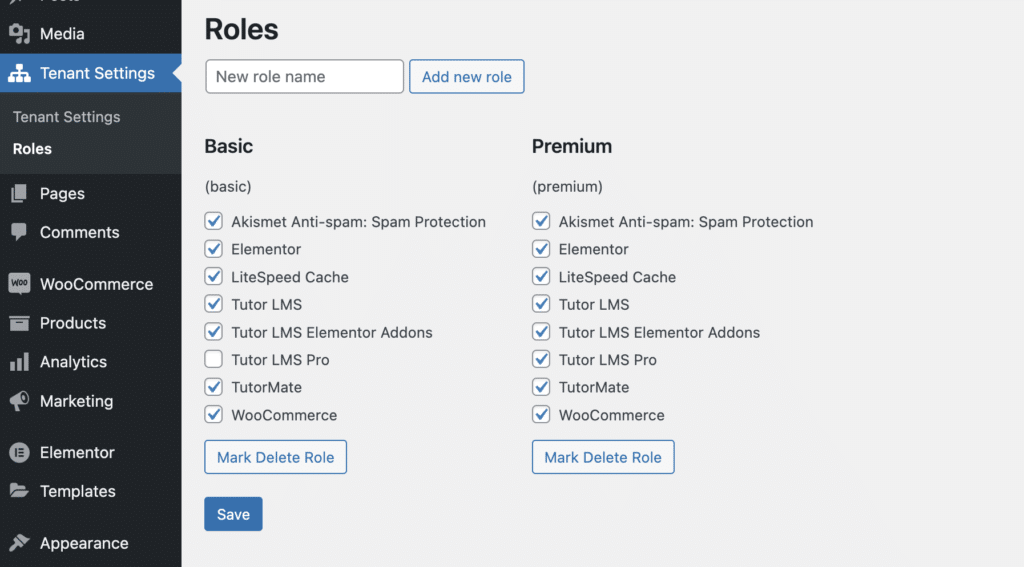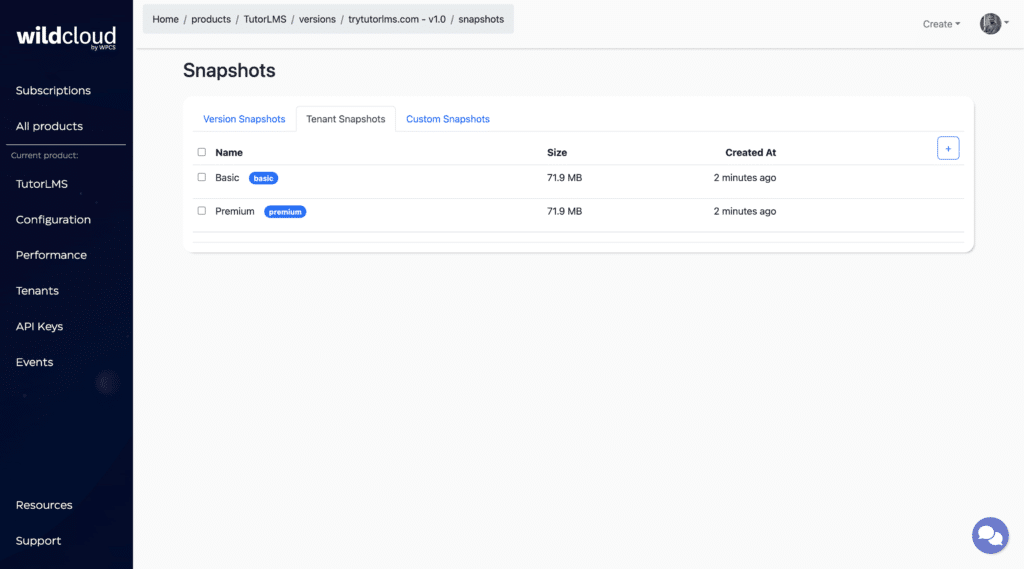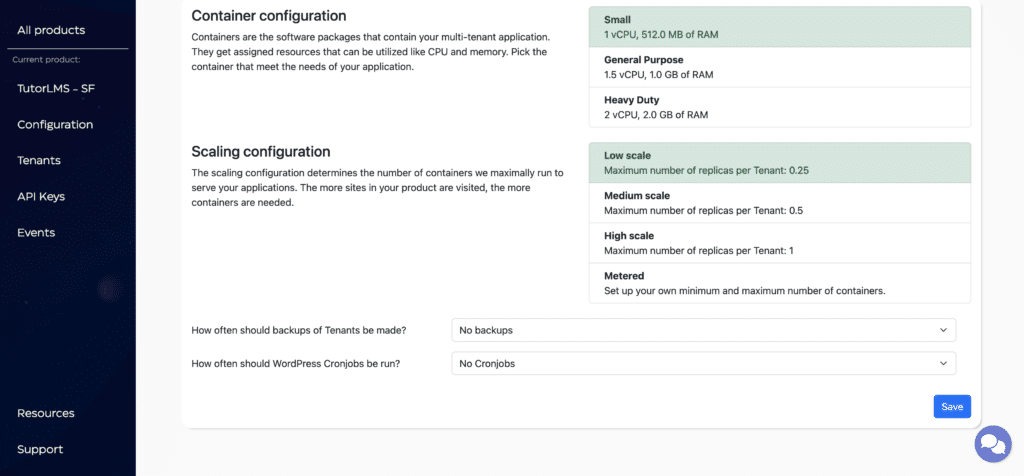Overview and Scope
The Blueprint is created by wildcloud in partnership with Themeum. The idea behind the solution is to offer their plugin suite combined with a multi-tenant cloud architecture, establishing a robust alternative to platforms like Udemy or Skillshare. What sets it apart is that end users get their own separate website, allowing them to avoid dependency on a proprietary solution that charges fees for every course sold.
On the flip side, creating an e-learning environment from scratch can be a daunting task. Regardless of how user-friendly TutorLMS builds its solution, there’s still the need to set up hosting, design, and configure an entire website for the end customer. That’s where TutorCloud steps in!
With TutorCloud, you get a ready-to-go solution, fully hosted and equipped with all the necessary plugins. While you will still have to customise aspects like branding and settings, this Blueprint serves as a starting point. Its primary purpose is to demonstrate how an e-learning platform can operate on wildcloud, addressing key considerations such as plan design, product offering, and a approach to license keys.
Upon signing up for a trial, you’ll find this Blueprint in the library, ready to accelerate your e-learning platform.
Watch the walkthrough in real time
TutorCloud Blueprint
At the heart of TutorCloud is the TutorLMS plugin, morphing the platform into a dynamic, feature-rich E-learning Platform on WordPress. The Blueprint stands as a template, empowering educators and entrepreneurs to create a E-learning Platform minus the hassles of building one from the ground up, and consists out of two parts:
1. The User-Facing Storefront
Serving as the primary touchpoint between your users and your brand, the storefront acts as both your marketing hub and client portal. Here, users engage with your brand, log in to their course sites, and much more.

It harnesses the prowess of our WaaS plugin suite, transforming the WooCommerce ‘My Account’ page into a multifaceted portal. From domain modifications and plan transitions to logging into their dedicated sites, it’s a seamless experience for the user.

To further enhance user experience, you could (and should), for example, integrate a support hub and documentation, ensuring users have every resource at their fingertips to thrive on their websites, similar to how all SaaS companies run their business.
2. The Core Application
Beyond the storefront lies the essence of the offering – the primary application template your customers receive post-purchase. This environment hosts all of the tenant sites of your users. It also ensures that they revel in the latest updates but it also fosters a streamlined development workflow using our version control system. It’s where the magic happens, with each user’s individuality shining through their customized learning website and enjoy a shared codebase that you manage and continuously maintain and develop from a central place.

Both applications are integrated through an API connection, linking the main application to the storefront with the aid of our WaaS plugin suite.
Together, these components complete the TutorCloud Blueprint. Let’s take a closer look under the hood in the next section.
Plan structure: Basic and Premium
The plan structure in the Blueprint are pretty simple and straight forward. The Basic plan is essentially the free version of the plugin installed, setting the user up with all the basics your users need to run their course. Premium has all the features of the Pro plugin installed. For both Basic and Premium a role exists created by the WaaS Client plugin that provides access to the plugins suited with each plan respectively.

Basic Plan
Perfect for those beginning their e-learning journey, the Basic Plan introduces:
- Course builder for infinite lessons and courses
- Video player support
- Fundamental quiz functionalities
- Monetization mechanisms
Premium Plan
For a more advanced e-learning environment, the Premium Plan extends:
- Advanced course builder
- Enhanced quiz options
- Comprehensive reporting
- Email alerts
- Advanced course management tools
License Activation: Navigating The Process
The Blueprint only has single premium plugin—Tutor LMS Premium—only available under the Premium plan of our application. Given Themeum’s tiered licensing—with single, ten, or unlimited sites—it’s advisable to purchase the unlimited plan from the beginning. The resources required to automate the lower tiers and cycle every 10 seats a new license key make it a less scalable option. However, to showcase a few considerations, we present two approaches. Note: The Application Blueprint comes pre-installed with the second method.
1. Version Snapshots
Using this approach, every new installation has the license key installed. When a new customer subscribes, they receive a version snapshot complete with database configuration and the included license key. Essentially, a license key is merely a database table entry. This method is straightforward and especially apt if you possess unlimited seated license keys. While this installs the plugin’s license key in the user’s database, it doesn’t guarantee they can leverage the plugin’s benefits. The user roles you define with the WaaS client define accessibility. For instance, if a customer opts for the default plan with TutorLMS’s free version, the Premium plugin remains inactive. Again, customers don’t have access to the plugins tab so they won’t be able to switch it on themselves.
A significant advantage of version snapshots is the seamless upgrade: If a customer later decides to the features of our premium subscription plan, the customer can switch plans easily and it requires no manual intervention on your part.
2. Tenant Snapshot
Alternatively, ensuring premium keys are only allocated to customers who’ve purchased the relevant plans, Tenant Snapshots is the way to go. Instead of universally embedding license keys, you can reduce overhead by generating specific tenant snapshots for each plan. As an illustration, our blueprint includes two Tenant Snapshots, corresponding to the Basic and Premium plans from the WaaS Client. Each snapshot contains its respective database configurations, with the Premium snapshot housing Tutor LMS’s premium license key. This ensures only Premium plan purchasers have the license in their database.

Of course, the Premium tenant snapshot doesn’t actually host the license key or the pro plugin, as it for demonstration purchases only. If you wish to use TutorCloud in this set-up, you need to purchase their paid plugin yourself and place it in the tenant. Then, create a version snapshot or a new tenant snapshot with the same “group-name” and you’re good to go. Now, the Storefront site knows which Snapshot too call — the latest Snapshot with the GroupName “Premium”.
A limitation with tenant snapshots is the need for manual intervention if a customer wishes to upgrade to the premium plan later. You could explore license key cycling, but this is resource-intensive to set-up as mentioned earlier. For many plugins, this isn’t cost-effective due to reasonably priced unlimited plans from most companies. In rare cases where a preferred plugin doesn’t offer an unlimited license plan, manual cycling or custom solutions become necessary. Rest assured, creating such automations is feasible. We also offer a Glove Service to assist in crafting license activation amongst other services to help you go to market faster.
Let’s take a look into how it is configured in the Storefront site!
Storefront site: Set-up
Upon accessing the Storefront tenant, we see two WooCommerce products. A product or our Basic plan and a product with our Premium plan.

- The Role titled “Premium” as created by the WaaS Client, which is responsible for website functionality.
- The Tenant Snapshot labeled “Premium” to facilitate the integration of the license key into the database.
The Basic plan mirrors this setup in its structure.
Within the WooCommerce products, both the WPCS product and subscriptions options are ticked. This indicates the following:
- The product functions as a subscription item, managed by WooCommerce subscriptions, which oversees recurring payments such as monthly or weekly billing.
- The item qualifies as a WPCS product. As a result, a new tab surfaces, displaying both the Role and Tenant Snapshot selection. Additionally, selecting a WPCS product introduces an extra field during the checkout process, prompting customers for a website name.

Once the WooCommerce products are set up, we can shift our focus to the front-end and see how both applications work together. Our Storefront is now live and ready to process orders. The checkout procedure is like any other WooCommerce checkout flow: a customer simply adds a website subscription to their cart and follows the checkout-procedure. After purchase a new customer tenant is provisioned in your Core Application, and becomes part of all future updates. In turn, a customer receives an email roughly 1-2 minutes after purchase with their site credentials.

Configuration Insights
TutorCloud is best described as a single-feature SaaS solution. Its primary function is as an LMS, making it an ideal candidate for our General Purpose container, equipped with 1.5 vCPU and 1.0 GB of RAM per container.

Based on usage patterns and insights from other LMS Course Platforms hosted by us, we suggest your application could fall into either the low or medium scale of our pre-configured plans. The low-scale option supports up to 5k users, while the medium scale can accommodate up to 12k monthly users.
Alternatively, upon joining our professional plan, you have the flexibility to choose our metered pricing, ensuring charges are based on actual usage. Additionally, this plan grants you access to our monitoring tools, offering valuable insights into resource utilization, and guaranteeing you achieve maximum cost-efficiency. Contact us if you have any inquires on the metered plan.
Making TutorCloud Blueprint Your Own
Understanding that one size doesn’t fit all, the TutorCloud blueprint is designed to be adaptable. Here’s how different target audiences can benefit:
1. Independent Educators & Entrepreneurs
Use the TutorCloud blueprint to quickly set up your own branded eLearning platform. Market this to individual educators who’ve longed for a personal eLearning space but lack the technical skills. They’ll enjoy a platform that rivals Udemy or Skillshare, but with their unique brand stamp.
2. Marketplace Visionaries
Dreaming of an eLearning marketplace? TutorCloud’s blueprint can be your foundation. Create a space where multiple educators collaborate, much like Udemy or Coursera. Activate the marketplace feature with ease, and diversify your course offerings.
To enable this function, all you really need to do is from your dashboard, go to the ‘Settings’ section of the Tutor LMS plugin. Then, head towards Instructors and enable the ‘Course Marketplace’ option.
3. Institutions & Organizations
For institutions eyeing a digital transformation or those wanting an online extension, the TutorCloud blueprint is ideal. Offer branded, certificate-driven courses tailored to institutional needs.
In a digital age where uniqueness sells, TutorCloud’s blueprint is your ticket to crafting a distinct eLearning platform. Seize it, customize it, and present your audience with an unparalleled learning experience.
Conclusion
Whether you’re planning to target educators, eyeing a niche market, or an institution aiming for digital transformation, TutorCloud provides the tools and the canvas to carve a niche in the e-learning domain. Why have users rely on mainstream platforms when you can offer a personalised experience to your audience? Get started with your E-learning empire with the TutorCloud Application Blueprint today.